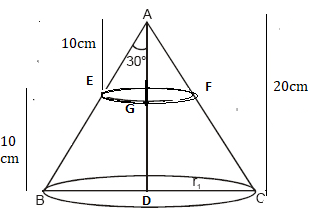Quick actions
Stay organised
Bookmark tricky proofs or add doubts to your dashboard so they resurface before exams.
Open dashboard →NCERT Solutions for Class 10 Maths Chapter 13 – Surface Areas and Volumes
Master "Surface Areas and Volumes" with step-by-step NCERT solutions.
Exercise 13.4
Question 1
.A drinking glass is in the shape of a frustum of a cone of height 14 cm. The diameters of its two circular ends are 4 cm and 2 cm. Find the capacity of the glass.Answer 1
Radius r1 of the upper end = 4/2 = 2 cm
Radius (r2) of lower the end = 2/2 = 1 cm
Height = 14 cm
Capacity of glass = Volume of frustum of cone
Capacity of glass = (1/3)×π×h(r12+r22+r1r2)
= (1/3)× π × (14)(22+12+ (2)(1))
∴ The capacity of the glass = 102×(2/3) cm3
Question 2
. The slant height of a frustum of a cone is 4 cm and the perimeters (circumference) of its circular ends are 18 cm and 6 cm. Find the surface area of the frustum.Answer 2
Given,
Slant height l = 4 cm
Circumference of upper end of the frustum = 18 cm
∴ 2πr1 = 18
Or, r1 = 9/π
circumference of lower end of the frustum = 6 cm
∴ 2πr2 = 6
Or, r2 = 6/π
Now, Coverd surface area of frustum = π(r1+r2) × l
= π(9/π+6/π) × 4
= 12×4 = 48 cm2
Question 3
A fez, the cap used by the Turks, is shaped like the frustum of a cone (see Fig.). If its radius on the open side is 10 cm, radius at the upper base is 4 cm and its slant height is 15 cm, find the area of material used for making it.
Answer 3
Given,
the radius of lower end,(r1) = 10 cm
radius of upper end, (r2) = 4 cm
Slant height l of frustum = 15 cm
Now,
The area of material to be used for making the fez = Coverd surface area of frustum + Area of upper circular end
Coverd surface area of frustum = π(r1+r2)×l
= 210π
And, Area of upper end = πr22
= 16π
∴ The area of material used = 710 × (2/7) cm2
Question 4
. A container, opened from the top and made up of a metal sheet, is in the form of a frustum of a cone of height 16 cm with radii of its lower and upper ends as 8 cm and 20 cm, respectively. Find the cost of the milk which can completely fill the container, at the rate of Rs. 20 per litre. Also find the cost of metal sheet used to make the container, if it costs Rs. 8 per 100 cm2.Answer 4
Given,
r1 = 20 cm,
r2 = 8 cm and
h = 16 cm
∴ Volume of the frustum = (1/3)×π×h(r12+r22+r1r2)
the rate of milk = Rs. 20/litre
So, Cost of milk = 20×volume of the frustum
= Rs. 209
slant height will be
So, CSA of the container = π(r1+r2)×l
l= 1758.4 cm2
the total metal that would be required to make container will be = 1758.4 + (Area of bottom circle)
= 1758.4+201 = 1959.4 cm2
∴ Total cost of metal = Rs. (8/100) × 1959.4 = Rs. 157
Question 5
A metallic right circular cone 20 cm high and whose vertical angle is 60° is cut into two parts at the middle of its height by a plane parallel to its base. If the frustum so obtained is drawn into a wire of diameter 1/16 cm, find the length of the wire.Answer

Consider AEG
Radius r1 of upper end of frustum =Radius r2 of lower end of container =
Height h3 of container = 10 cm
Now,
Volume of the frustum =On Solving this we get,
Volume of the frustum =The radius r of wire =
Now,
Let the length of wire is l.
Volume of wire = Area of cross-section x Length
= (πr2)xl
= π (Now, Volume of frustum = Volume of wire
we get,
l = 7964.44 m
Chapter shortcuts
- Chapter 1 · Real Numbers
- Chapter 2 · Polynomials
- Chapter 3 · Pair of Linear Equations in Two Variables
- Chapter 4 · Quadratic Equations
- Chapter 5 · Arithmetic Progressions
- Chapter 6 · Triangles
- Chapter 7 · Coordinate Geometry
- Chapter 8 · Introduction to Trigonometry
- Chapter 9 · Some Applications of Trigonometry
- Chapter 10 · Circles
- Chapter 11 · Constructions
- Chapter 12 · Area Related to Circles
- Chapter 13 · Surface Areas and Volumes
- Chapter 14 · Statistics
- Chapter 15 · Probability